Significance of Organisational Design Theory in Fulfilling Organisational Strategy
VerifiedAdded on 2022/12/27
|11
|3662
|53
AI Summary
This report evaluates the significance of organisational design theory in relation to organisational structure and strategy fulfillment. It analyzes different approaches and techniques used to attract, maintain, develop, and reward human resources to create a skilled and dedicated workforce. It also evaluates how organisational design responds and adapts to change management.
Contribute Materials
Your contribution can guide someone’s learning journey. Share your
documents today.
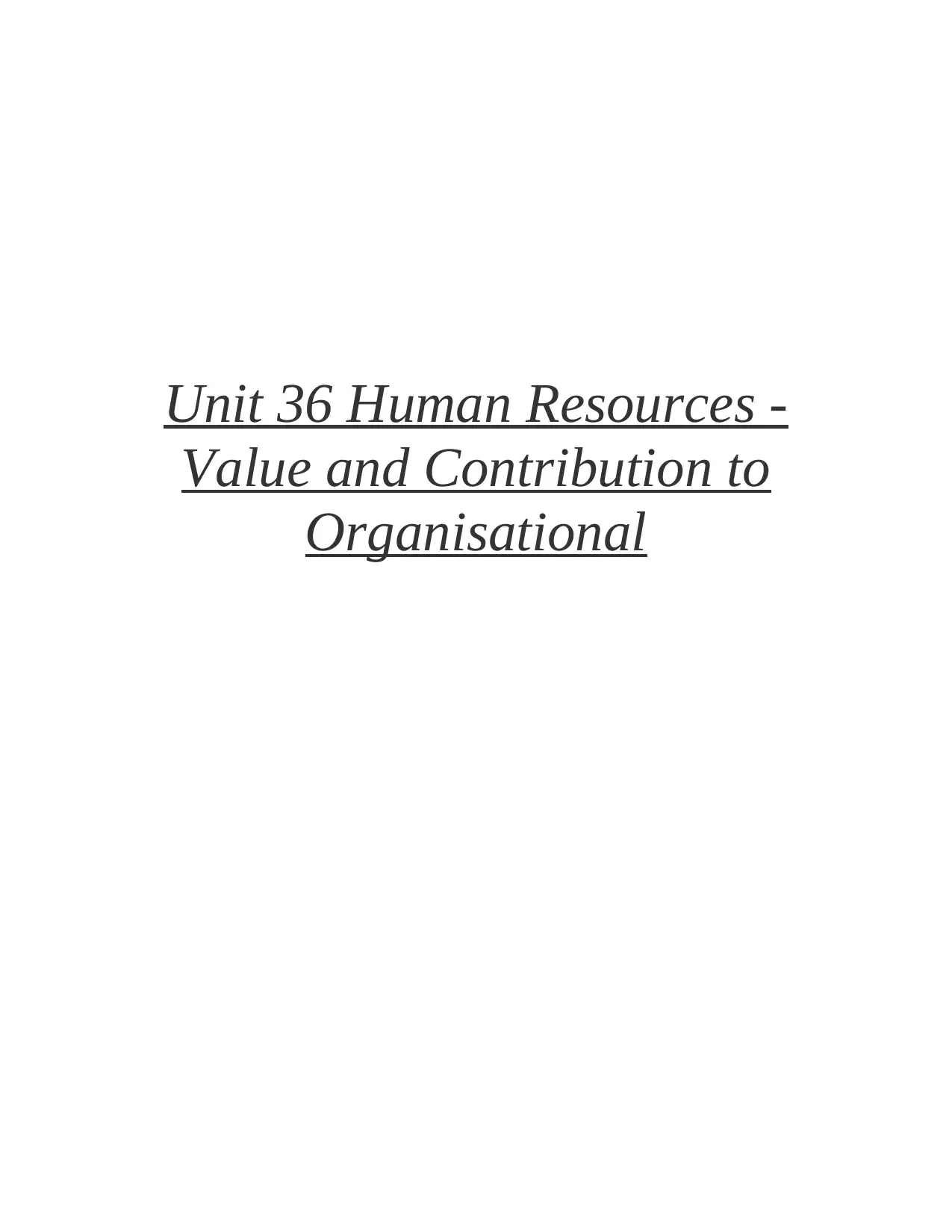
Unit 36 Human Resources -
Value and Contribution to
Organisational
Value and Contribution to
Organisational
Secure Best Marks with AI Grader
Need help grading? Try our AI Grader for instant feedback on your assignments.
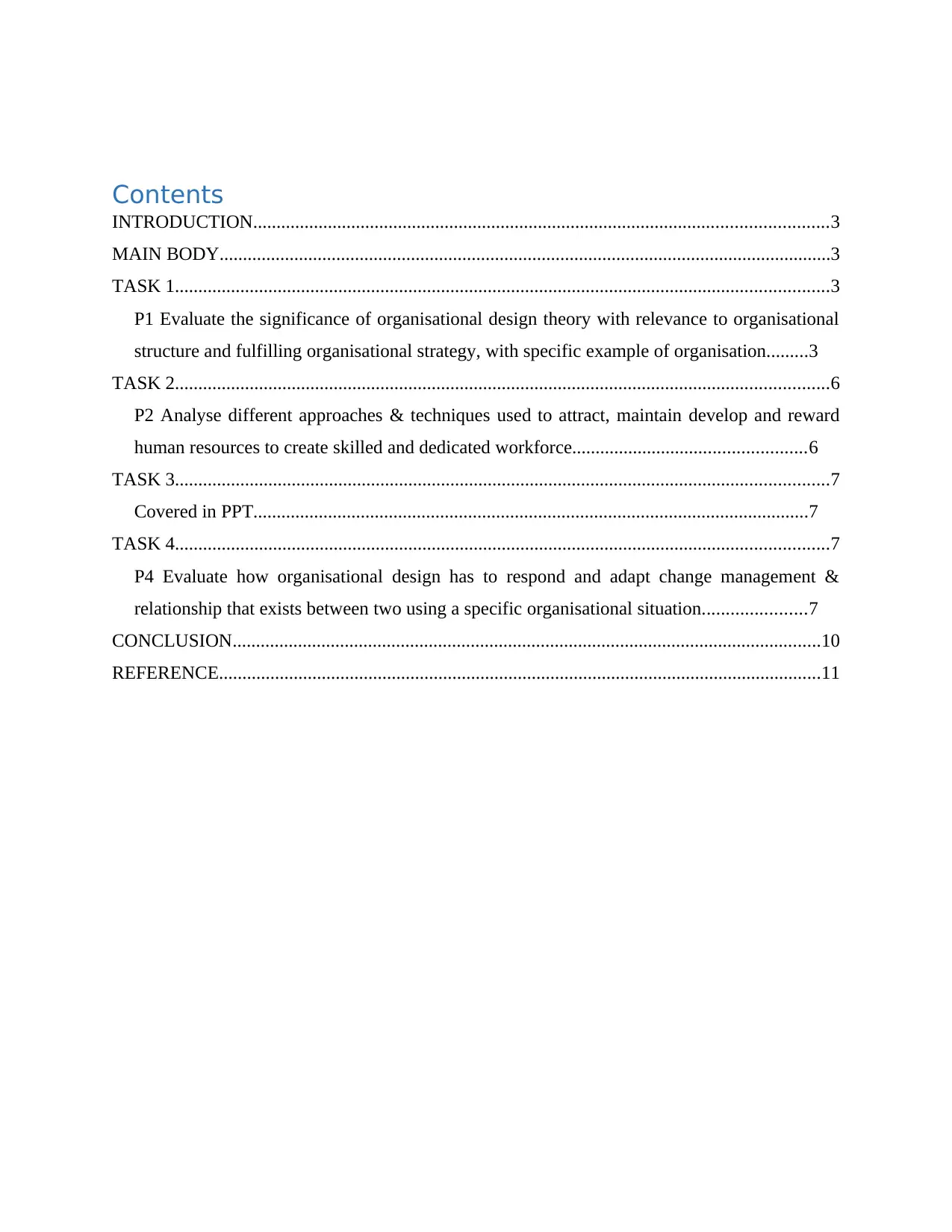
Contents
INTRODUCTION...........................................................................................................................3
MAIN BODY...................................................................................................................................3
TASK 1............................................................................................................................................3
P1 Evaluate the significance of organisational design theory with relevance to organisational
structure and fulfilling organisational strategy, with specific example of organisation.........3
TASK 2............................................................................................................................................6
P2 Analyse different approaches & techniques used to attract, maintain develop and reward
human resources to create skilled and dedicated workforce..................................................6
TASK 3............................................................................................................................................7
Covered in PPT.......................................................................................................................7
TASK 4............................................................................................................................................7
P4 Evaluate how organisational design has to respond and adapt change management &
relationship that exists between two using a specific organisational situation......................7
CONCLUSION..............................................................................................................................10
REFERENCE.................................................................................................................................11
INTRODUCTION...........................................................................................................................3
MAIN BODY...................................................................................................................................3
TASK 1............................................................................................................................................3
P1 Evaluate the significance of organisational design theory with relevance to organisational
structure and fulfilling organisational strategy, with specific example of organisation.........3
TASK 2............................................................................................................................................6
P2 Analyse different approaches & techniques used to attract, maintain develop and reward
human resources to create skilled and dedicated workforce..................................................6
TASK 3............................................................................................................................................7
Covered in PPT.......................................................................................................................7
TASK 4............................................................................................................................................7
P4 Evaluate how organisational design has to respond and adapt change management &
relationship that exists between two using a specific organisational situation......................7
CONCLUSION..............................................................................................................................10
REFERENCE.................................................................................................................................11
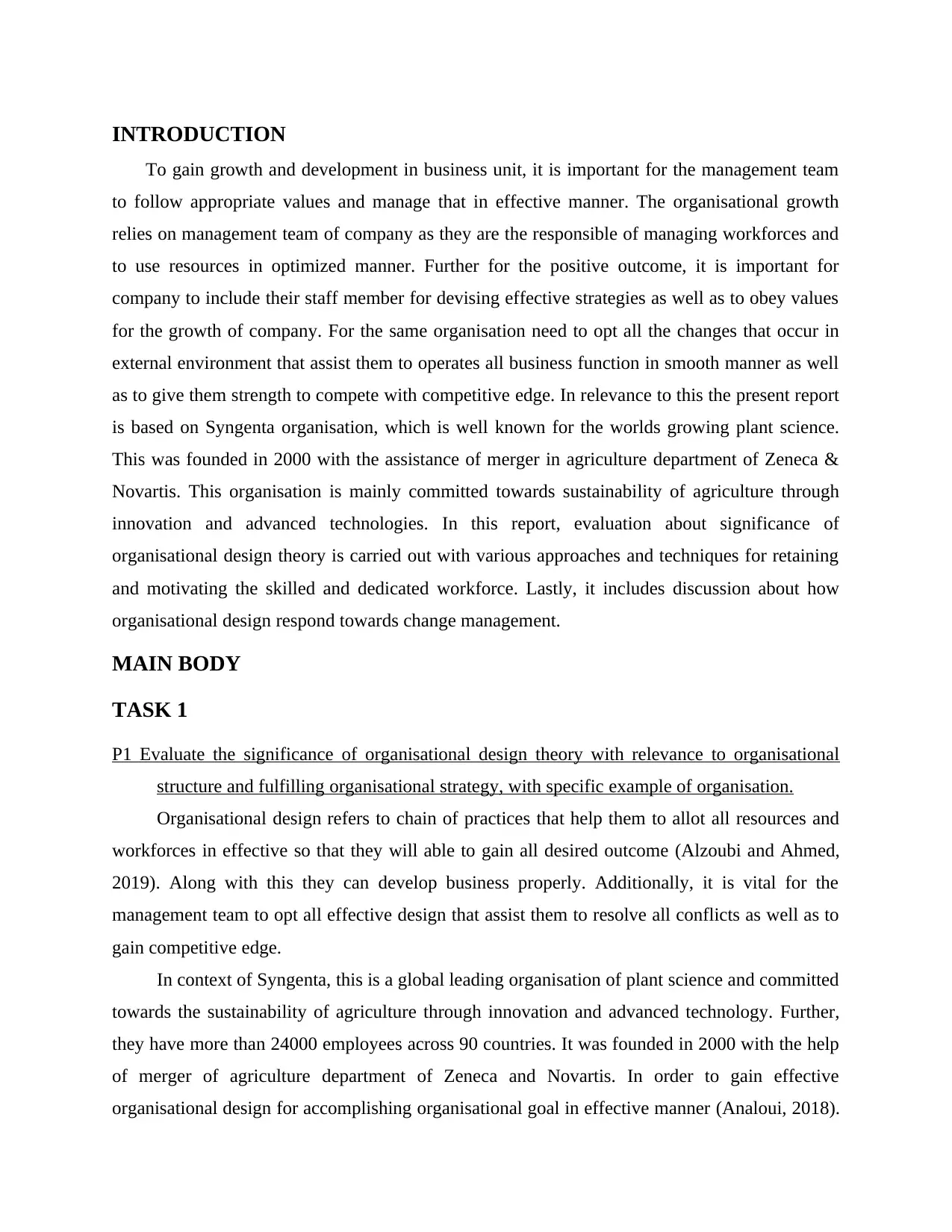
INTRODUCTION
To gain growth and development in business unit, it is important for the management team
to follow appropriate values and manage that in effective manner. The organisational growth
relies on management team of company as they are the responsible of managing workforces and
to use resources in optimized manner. Further for the positive outcome, it is important for
company to include their staff member for devising effective strategies as well as to obey values
for the growth of company. For the same organisation need to opt all the changes that occur in
external environment that assist them to operates all business function in smooth manner as well
as to give them strength to compete with competitive edge. In relevance to this the present report
is based on Syngenta organisation, which is well known for the worlds growing plant science.
This was founded in 2000 with the assistance of merger in agriculture department of Zeneca &
Novartis. This organisation is mainly committed towards sustainability of agriculture through
innovation and advanced technologies. In this report, evaluation about significance of
organisational design theory is carried out with various approaches and techniques for retaining
and motivating the skilled and dedicated workforce. Lastly, it includes discussion about how
organisational design respond towards change management.
MAIN BODY
TASK 1
P1 Evaluate the significance of organisational design theory with relevance to organisational
structure and fulfilling organisational strategy, with specific example of organisation.
Organisational design refers to chain of practices that help them to allot all resources and
workforces in effective so that they will able to gain all desired outcome (Alzoubi and Ahmed,
2019). Along with this they can develop business properly. Additionally, it is vital for the
management team to opt all effective design that assist them to resolve all conflicts as well as to
gain competitive edge.
In context of Syngenta, this is a global leading organisation of plant science and committed
towards the sustainability of agriculture through innovation and advanced technology. Further,
they have more than 24000 employees across 90 countries. It was founded in 2000 with the help
of merger of agriculture department of Zeneca and Novartis. In order to gain effective
organisational design for accomplishing organisational goal in effective manner (Analoui, 2018).
To gain growth and development in business unit, it is important for the management team
to follow appropriate values and manage that in effective manner. The organisational growth
relies on management team of company as they are the responsible of managing workforces and
to use resources in optimized manner. Further for the positive outcome, it is important for
company to include their staff member for devising effective strategies as well as to obey values
for the growth of company. For the same organisation need to opt all the changes that occur in
external environment that assist them to operates all business function in smooth manner as well
as to give them strength to compete with competitive edge. In relevance to this the present report
is based on Syngenta organisation, which is well known for the worlds growing plant science.
This was founded in 2000 with the assistance of merger in agriculture department of Zeneca &
Novartis. This organisation is mainly committed towards sustainability of agriculture through
innovation and advanced technologies. In this report, evaluation about significance of
organisational design theory is carried out with various approaches and techniques for retaining
and motivating the skilled and dedicated workforce. Lastly, it includes discussion about how
organisational design respond towards change management.
MAIN BODY
TASK 1
P1 Evaluate the significance of organisational design theory with relevance to organisational
structure and fulfilling organisational strategy, with specific example of organisation.
Organisational design refers to chain of practices that help them to allot all resources and
workforces in effective so that they will able to gain all desired outcome (Alzoubi and Ahmed,
2019). Along with this they can develop business properly. Additionally, it is vital for the
management team to opt all effective design that assist them to resolve all conflicts as well as to
gain competitive edge.
In context of Syngenta, this is a global leading organisation of plant science and committed
towards the sustainability of agriculture through innovation and advanced technology. Further,
they have more than 24000 employees across 90 countries. It was founded in 2000 with the help
of merger of agriculture department of Zeneca and Novartis. In order to gain effective
organisational design for accomplishing organisational goal in effective manner (Analoui, 2018).
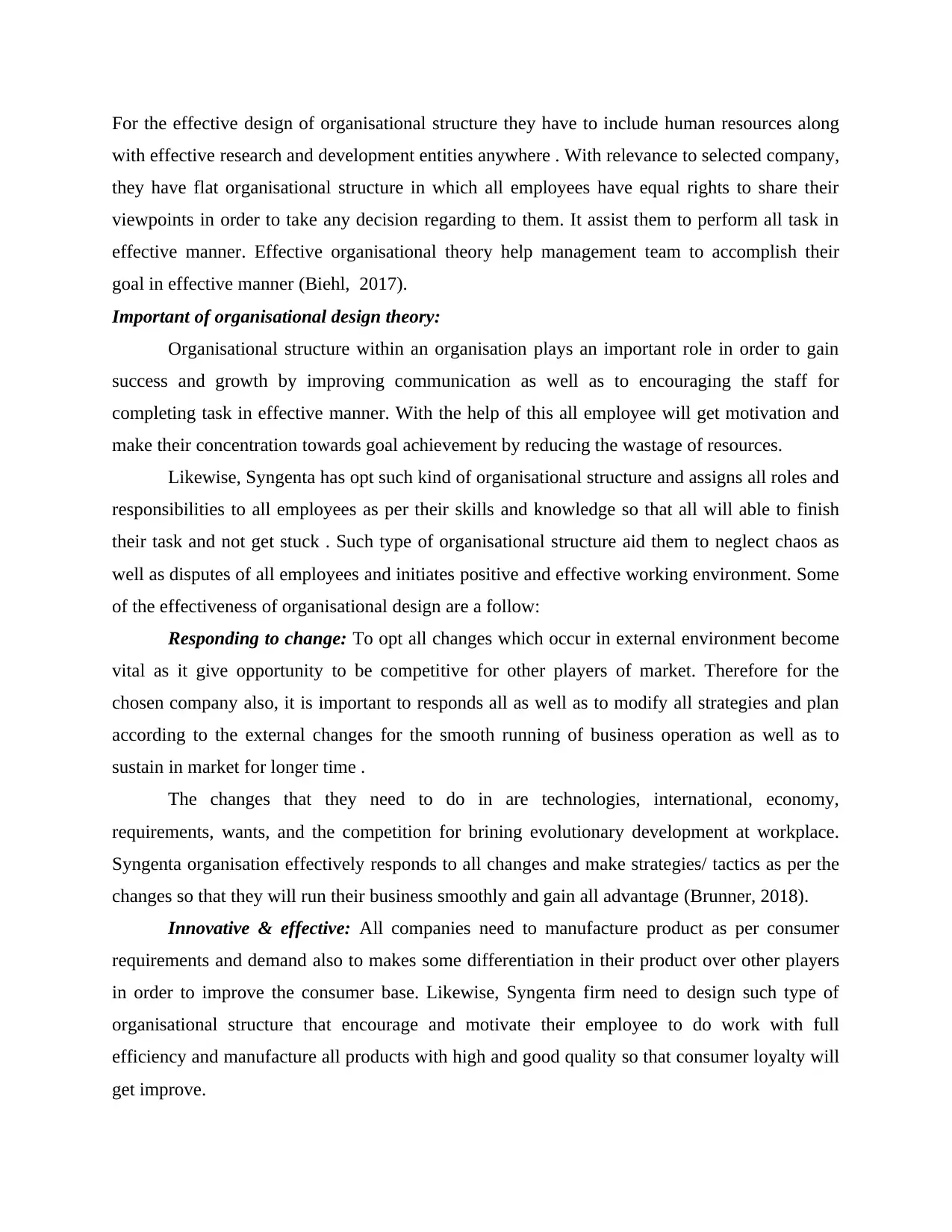
For the effective design of organisational structure they have to include human resources along
with effective research and development entities anywhere . With relevance to selected company,
they have flat organisational structure in which all employees have equal rights to share their
viewpoints in order to take any decision regarding to them. It assist them to perform all task in
effective manner. Effective organisational theory help management team to accomplish their
goal in effective manner (Biehl, 2017).
Important of organisational design theory:
Organisational structure within an organisation plays an important role in order to gain
success and growth by improving communication as well as to encouraging the staff for
completing task in effective manner. With the help of this all employee will get motivation and
make their concentration towards goal achievement by reducing the wastage of resources.
Likewise, Syngenta has opt such kind of organisational structure and assigns all roles and
responsibilities to all employees as per their skills and knowledge so that all will able to finish
their task and not get stuck . Such type of organisational structure aid them to neglect chaos as
well as disputes of all employees and initiates positive and effective working environment. Some
of the effectiveness of organisational design are a follow:
Responding to change: To opt all changes which occur in external environment become
vital as it give opportunity to be competitive for other players of market. Therefore for the
chosen company also, it is important to responds all as well as to modify all strategies and plan
according to the external changes for the smooth running of business operation as well as to
sustain in market for longer time .
The changes that they need to do in are technologies, international, economy,
requirements, wants, and the competition for brining evolutionary development at workplace.
Syngenta organisation effectively responds to all changes and make strategies/ tactics as per the
changes so that they will run their business smoothly and gain all advantage (Brunner, 2018).
Innovative & effective: All companies need to manufacture product as per consumer
requirements and demand also to makes some differentiation in their product over other players
in order to improve the consumer base. Likewise, Syngenta firm need to design such type of
organisational structure that encourage and motivate their employee to do work with full
efficiency and manufacture all products with high and good quality so that consumer loyalty will
get improve.
with effective research and development entities anywhere . With relevance to selected company,
they have flat organisational structure in which all employees have equal rights to share their
viewpoints in order to take any decision regarding to them. It assist them to perform all task in
effective manner. Effective organisational theory help management team to accomplish their
goal in effective manner (Biehl, 2017).
Important of organisational design theory:
Organisational structure within an organisation plays an important role in order to gain
success and growth by improving communication as well as to encouraging the staff for
completing task in effective manner. With the help of this all employee will get motivation and
make their concentration towards goal achievement by reducing the wastage of resources.
Likewise, Syngenta has opt such kind of organisational structure and assigns all roles and
responsibilities to all employees as per their skills and knowledge so that all will able to finish
their task and not get stuck . Such type of organisational structure aid them to neglect chaos as
well as disputes of all employees and initiates positive and effective working environment. Some
of the effectiveness of organisational design are a follow:
Responding to change: To opt all changes which occur in external environment become
vital as it give opportunity to be competitive for other players of market. Therefore for the
chosen company also, it is important to responds all as well as to modify all strategies and plan
according to the external changes for the smooth running of business operation as well as to
sustain in market for longer time .
The changes that they need to do in are technologies, international, economy,
requirements, wants, and the competition for brining evolutionary development at workplace.
Syngenta organisation effectively responds to all changes and make strategies/ tactics as per the
changes so that they will run their business smoothly and gain all advantage (Brunner, 2018).
Innovative & effective: All companies need to manufacture product as per consumer
requirements and demand also to makes some differentiation in their product over other players
in order to improve the consumer base. Likewise, Syngenta firm need to design such type of
organisational structure that encourage and motivate their employee to do work with full
efficiency and manufacture all products with high and good quality so that consumer loyalty will
get improve.
Secure Best Marks with AI Grader
Need help grading? Try our AI Grader for instant feedback on your assignments.

Aligning organisational objective: It is important for all the companies to align their
objective and make string vision and mission statement and by opting and designing suitable
organisational structure it is possible to full fill this aim and gain success . To deal with the
dynamic nature for obtaining optimal result, Syngenta Company have proper control on their
business function/ operation.
Integration of new elements: To attain all goal easily as well as to operate function
smoothly, respective company reacts towards changes of market in effective manner by
exploring all market and developing themselves. To gain positive outcome, their effective
organisational structure assist them to integrate new corporate strategy and make all modification
accordingly (Cantoni and Mangia, 2018).
For the betterment of company, Syngenta organisation try to opt matrix organisational
structure as it can help them to opt all advanced technology by managing all workforces in
effective way as well as by providing the trendy and preferred services to their potential
consumer . Additionally, it assist them to develop creative team that assign role that bring all
those together who have similar competencies and that are beneficial for company in positive
manner.
Dealing with contingencies: Strong organisational design of enterprise assist
management team to compete with eventualities and offer them chance to gain all competitive
advantage at marketplace. By adapting all advanced technology and innovation, the strength and
capabilities of employee will able to recognise also give them opportunity to opt all these
complex task and gain all competitive advantage Carayannis and Meissner, 2017).
Organisational design theory coordinating elements: The main aim of adhering effective
organisational structure is to develop and foster diversity within company based on race, gender,
sex, and source of employees that may influence the effectiveness of business unit incentives .
Similarly, this help personnel of company in enhancing the performance, efficiency etc.
TASK 2
P2 Analyse different approaches & techniques used to attract, maintain develop and reward
human resources to create skilled and dedicated workforce.
The factor that inspire an individual to work with full dedication and efficiency and that
factor is term out as motivation.
objective and make string vision and mission statement and by opting and designing suitable
organisational structure it is possible to full fill this aim and gain success . To deal with the
dynamic nature for obtaining optimal result, Syngenta Company have proper control on their
business function/ operation.
Integration of new elements: To attain all goal easily as well as to operate function
smoothly, respective company reacts towards changes of market in effective manner by
exploring all market and developing themselves. To gain positive outcome, their effective
organisational structure assist them to integrate new corporate strategy and make all modification
accordingly (Cantoni and Mangia, 2018).
For the betterment of company, Syngenta organisation try to opt matrix organisational
structure as it can help them to opt all advanced technology by managing all workforces in
effective way as well as by providing the trendy and preferred services to their potential
consumer . Additionally, it assist them to develop creative team that assign role that bring all
those together who have similar competencies and that are beneficial for company in positive
manner.
Dealing with contingencies: Strong organisational design of enterprise assist
management team to compete with eventualities and offer them chance to gain all competitive
advantage at marketplace. By adapting all advanced technology and innovation, the strength and
capabilities of employee will able to recognise also give them opportunity to opt all these
complex task and gain all competitive advantage Carayannis and Meissner, 2017).
Organisational design theory coordinating elements: The main aim of adhering effective
organisational structure is to develop and foster diversity within company based on race, gender,
sex, and source of employees that may influence the effectiveness of business unit incentives .
Similarly, this help personnel of company in enhancing the performance, efficiency etc.
TASK 2
P2 Analyse different approaches & techniques used to attract, maintain develop and reward
human resources to create skilled and dedicated workforce.
The factor that inspire an individual to work with full dedication and efficiency and that
factor is term out as motivation.
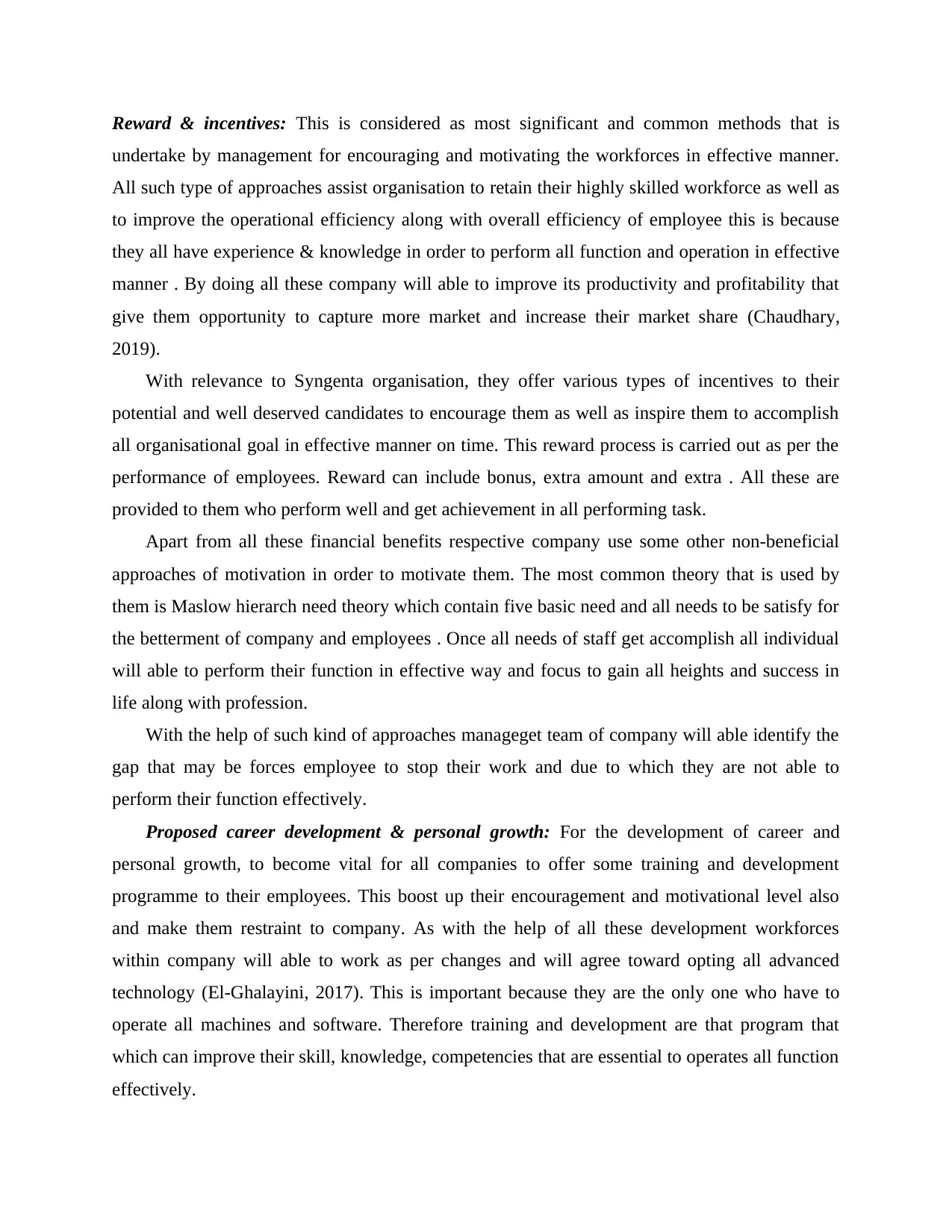
Reward & incentives: This is considered as most significant and common methods that is
undertake by management for encouraging and motivating the workforces in effective manner.
All such type of approaches assist organisation to retain their highly skilled workforce as well as
to improve the operational efficiency along with overall efficiency of employee this is because
they all have experience & knowledge in order to perform all function and operation in effective
manner . By doing all these company will able to improve its productivity and profitability that
give them opportunity to capture more market and increase their market share (Chaudhary,
2019).
With relevance to Syngenta organisation, they offer various types of incentives to their
potential and well deserved candidates to encourage them as well as inspire them to accomplish
all organisational goal in effective manner on time. This reward process is carried out as per the
performance of employees. Reward can include bonus, extra amount and extra . All these are
provided to them who perform well and get achievement in all performing task.
Apart from all these financial benefits respective company use some other non-beneficial
approaches of motivation in order to motivate them. The most common theory that is used by
them is Maslow hierarch need theory which contain five basic need and all needs to be satisfy for
the betterment of company and employees . Once all needs of staff get accomplish all individual
will able to perform their function in effective way and focus to gain all heights and success in
life along with profession.
With the help of such kind of approaches manageget team of company will able identify the
gap that may be forces employee to stop their work and due to which they are not able to
perform their function effectively.
Proposed career development & personal growth: For the development of career and
personal growth, to become vital for all companies to offer some training and development
programme to their employees. This boost up their encouragement and motivational level also
and make them restraint to company. As with the help of all these development workforces
within company will able to work as per changes and will agree toward opting all advanced
technology (El-Ghalayini, 2017). This is important because they are the only one who have to
operate all machines and software. Therefore training and development are that program that
which can improve their skill, knowledge, competencies that are essential to operates all function
effectively.
undertake by management for encouraging and motivating the workforces in effective manner.
All such type of approaches assist organisation to retain their highly skilled workforce as well as
to improve the operational efficiency along with overall efficiency of employee this is because
they all have experience & knowledge in order to perform all function and operation in effective
manner . By doing all these company will able to improve its productivity and profitability that
give them opportunity to capture more market and increase their market share (Chaudhary,
2019).
With relevance to Syngenta organisation, they offer various types of incentives to their
potential and well deserved candidates to encourage them as well as inspire them to accomplish
all organisational goal in effective manner on time. This reward process is carried out as per the
performance of employees. Reward can include bonus, extra amount and extra . All these are
provided to them who perform well and get achievement in all performing task.
Apart from all these financial benefits respective company use some other non-beneficial
approaches of motivation in order to motivate them. The most common theory that is used by
them is Maslow hierarch need theory which contain five basic need and all needs to be satisfy for
the betterment of company and employees . Once all needs of staff get accomplish all individual
will able to perform their function in effective way and focus to gain all heights and success in
life along with profession.
With the help of such kind of approaches manageget team of company will able identify the
gap that may be forces employee to stop their work and due to which they are not able to
perform their function effectively.
Proposed career development & personal growth: For the development of career and
personal growth, to become vital for all companies to offer some training and development
programme to their employees. This boost up their encouragement and motivational level also
and make them restraint to company. As with the help of all these development workforces
within company will able to work as per changes and will agree toward opting all advanced
technology (El-Ghalayini, 2017). This is important because they are the only one who have to
operate all machines and software. Therefore training and development are that program that
which can improve their skill, knowledge, competencies that are essential to operates all function
effectively.
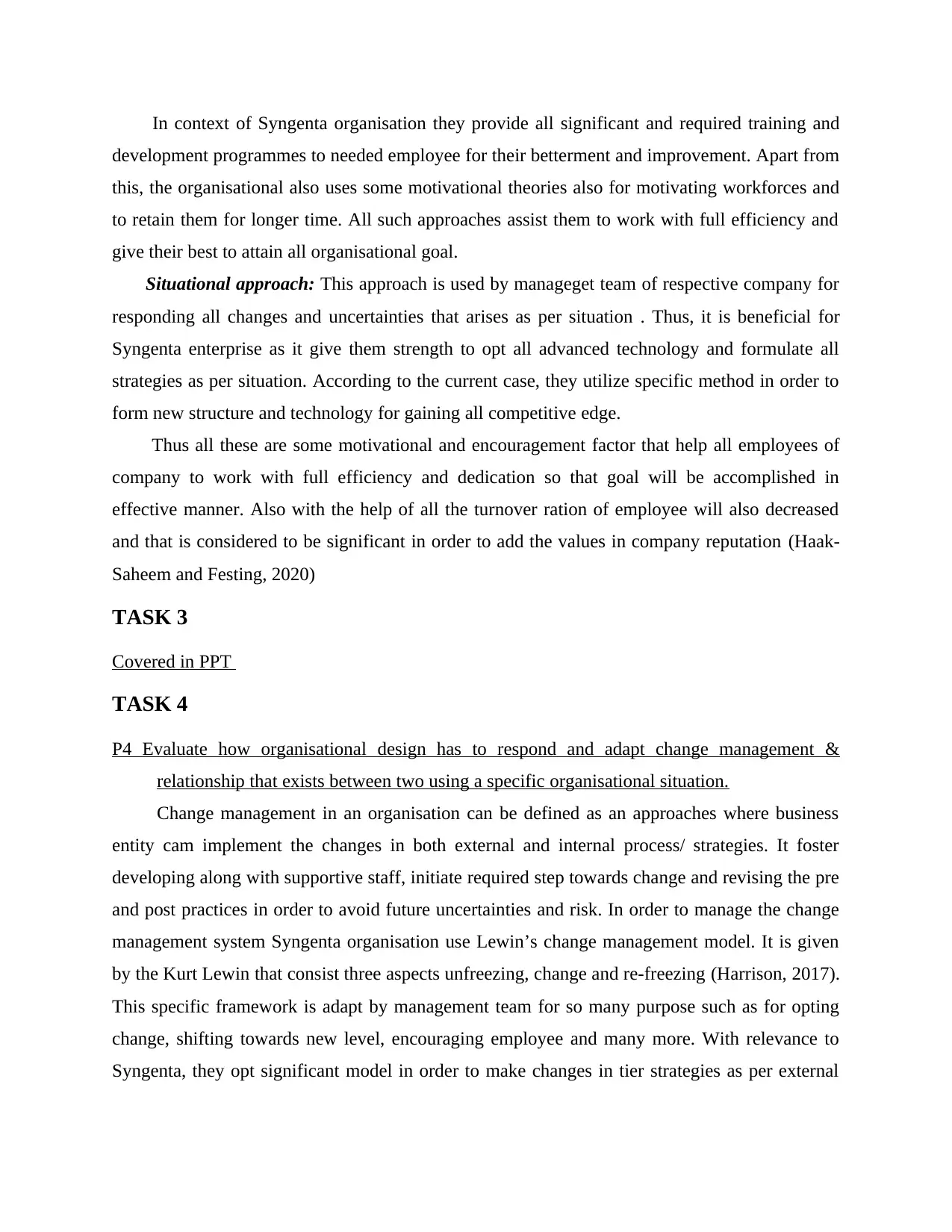
In context of Syngenta organisation they provide all significant and required training and
development programmes to needed employee for their betterment and improvement. Apart from
this, the organisational also uses some motivational theories also for motivating workforces and
to retain them for longer time. All such approaches assist them to work with full efficiency and
give their best to attain all organisational goal.
Situational approach: This approach is used by manageget team of respective company for
responding all changes and uncertainties that arises as per situation . Thus, it is beneficial for
Syngenta enterprise as it give them strength to opt all advanced technology and formulate all
strategies as per situation. According to the current case, they utilize specific method in order to
form new structure and technology for gaining all competitive edge.
Thus all these are some motivational and encouragement factor that help all employees of
company to work with full efficiency and dedication so that goal will be accomplished in
effective manner. Also with the help of all the turnover ration of employee will also decreased
and that is considered to be significant in order to add the values in company reputation (Haak-
Saheem and Festing, 2020)
TASK 3
Covered in PPT
TASK 4
P4 Evaluate how organisational design has to respond and adapt change management &
relationship that exists between two using a specific organisational situation.
Change management in an organisation can be defined as an approaches where business
entity cam implement the changes in both external and internal process/ strategies. It foster
developing along with supportive staff, initiate required step towards change and revising the pre
and post practices in order to avoid future uncertainties and risk. In order to manage the change
management system Syngenta organisation use Lewin’s change management model. It is given
by the Kurt Lewin that consist three aspects unfreezing, change and re-freezing (Harrison, 2017).
This specific framework is adapt by management team for so many purpose such as for opting
change, shifting towards new level, encouraging employee and many more. With relevance to
Syngenta, they opt significant model in order to make changes in tier strategies as per external
development programmes to needed employee for their betterment and improvement. Apart from
this, the organisational also uses some motivational theories also for motivating workforces and
to retain them for longer time. All such approaches assist them to work with full efficiency and
give their best to attain all organisational goal.
Situational approach: This approach is used by manageget team of respective company for
responding all changes and uncertainties that arises as per situation . Thus, it is beneficial for
Syngenta enterprise as it give them strength to opt all advanced technology and formulate all
strategies as per situation. According to the current case, they utilize specific method in order to
form new structure and technology for gaining all competitive edge.
Thus all these are some motivational and encouragement factor that help all employees of
company to work with full efficiency and dedication so that goal will be accomplished in
effective manner. Also with the help of all the turnover ration of employee will also decreased
and that is considered to be significant in order to add the values in company reputation (Haak-
Saheem and Festing, 2020)
TASK 3
Covered in PPT
TASK 4
P4 Evaluate how organisational design has to respond and adapt change management &
relationship that exists between two using a specific organisational situation.
Change management in an organisation can be defined as an approaches where business
entity cam implement the changes in both external and internal process/ strategies. It foster
developing along with supportive staff, initiate required step towards change and revising the pre
and post practices in order to avoid future uncertainties and risk. In order to manage the change
management system Syngenta organisation use Lewin’s change management model. It is given
by the Kurt Lewin that consist three aspects unfreezing, change and re-freezing (Harrison, 2017).
This specific framework is adapt by management team for so many purpose such as for opting
change, shifting towards new level, encouraging employee and many more. With relevance to
Syngenta, they opt significant model in order to make changes in tier strategies as per external
Paraphrase This Document
Need a fresh take? Get an instant paraphrase of this document with our AI Paraphraser
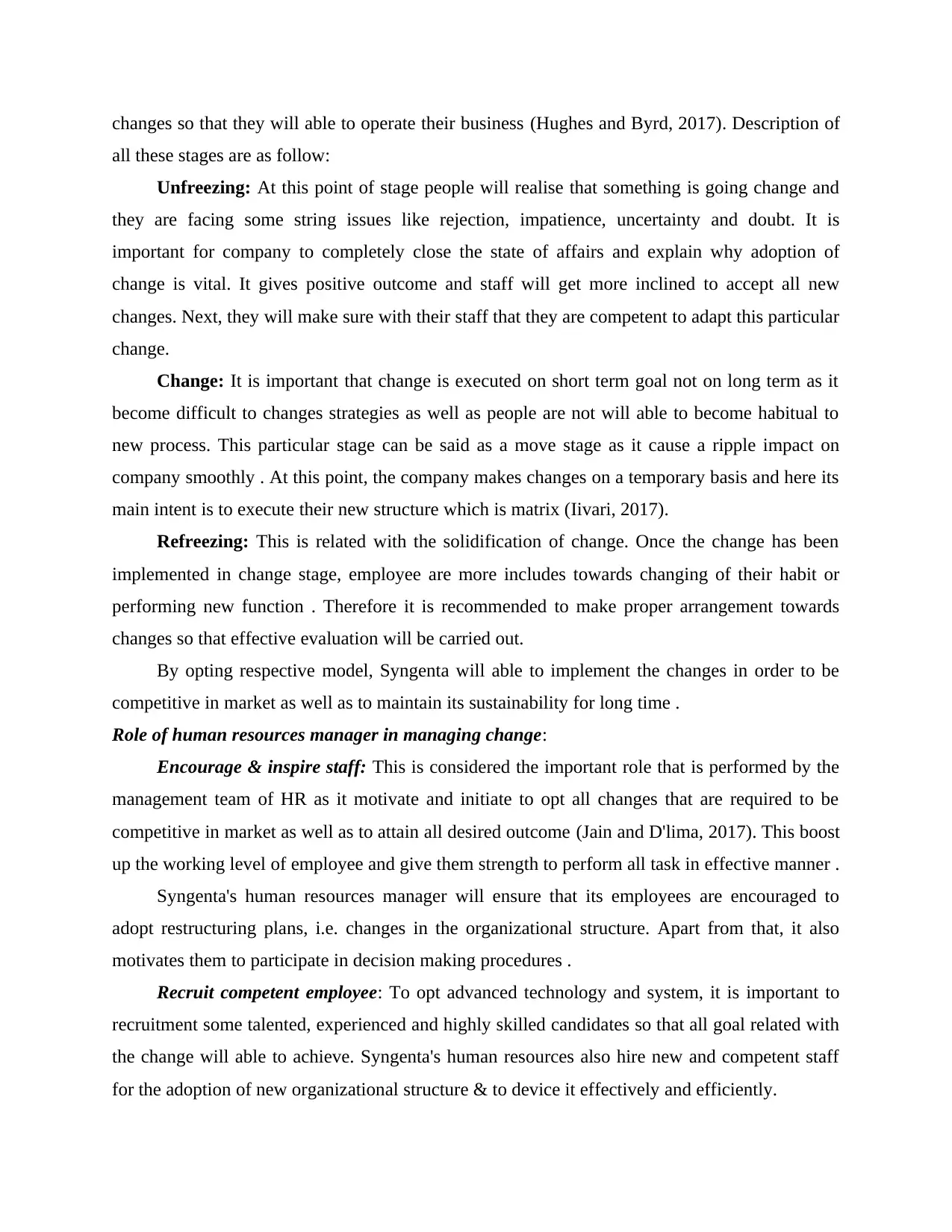
changes so that they will able to operate their business (Hughes and Byrd, 2017). Description of
all these stages are as follow:
Unfreezing: At this point of stage people will realise that something is going change and
they are facing some string issues like rejection, impatience, uncertainty and doubt. It is
important for company to completely close the state of affairs and explain why adoption of
change is vital. It gives positive outcome and staff will get more inclined to accept all new
changes. Next, they will make sure with their staff that they are competent to adapt this particular
change.
Change: It is important that change is executed on short term goal not on long term as it
become difficult to changes strategies as well as people are not will able to become habitual to
new process. This particular stage can be said as a move stage as it cause a ripple impact on
company smoothly . At this point, the company makes changes on a temporary basis and here its
main intent is to execute their new structure which is matrix (Iivari, 2017).
Refreezing: This is related with the solidification of change. Once the change has been
implemented in change stage, employee are more includes towards changing of their habit or
performing new function . Therefore it is recommended to make proper arrangement towards
changes so that effective evaluation will be carried out.
By opting respective model, Syngenta will able to implement the changes in order to be
competitive in market as well as to maintain its sustainability for long time .
Role of human resources manager in managing change:
Encourage & inspire staff: This is considered the important role that is performed by the
management team of HR as it motivate and initiate to opt all changes that are required to be
competitive in market as well as to attain all desired outcome (Jain and D'lima, 2017). This boost
up the working level of employee and give them strength to perform all task in effective manner .
Syngenta's human resources manager will ensure that its employees are encouraged to
adopt restructuring plans, i.e. changes in the organizational structure. Apart from that, it also
motivates them to participate in decision making procedures .
Recruit competent employee: To opt advanced technology and system, it is important to
recruitment some talented, experienced and highly skilled candidates so that all goal related with
the change will able to achieve. Syngenta's human resources also hire new and competent staff
for the adoption of new organizational structure & to device it effectively and efficiently.
all these stages are as follow:
Unfreezing: At this point of stage people will realise that something is going change and
they are facing some string issues like rejection, impatience, uncertainty and doubt. It is
important for company to completely close the state of affairs and explain why adoption of
change is vital. It gives positive outcome and staff will get more inclined to accept all new
changes. Next, they will make sure with their staff that they are competent to adapt this particular
change.
Change: It is important that change is executed on short term goal not on long term as it
become difficult to changes strategies as well as people are not will able to become habitual to
new process. This particular stage can be said as a move stage as it cause a ripple impact on
company smoothly . At this point, the company makes changes on a temporary basis and here its
main intent is to execute their new structure which is matrix (Iivari, 2017).
Refreezing: This is related with the solidification of change. Once the change has been
implemented in change stage, employee are more includes towards changing of their habit or
performing new function . Therefore it is recommended to make proper arrangement towards
changes so that effective evaluation will be carried out.
By opting respective model, Syngenta will able to implement the changes in order to be
competitive in market as well as to maintain its sustainability for long time .
Role of human resources manager in managing change:
Encourage & inspire staff: This is considered the important role that is performed by the
management team of HR as it motivate and initiate to opt all changes that are required to be
competitive in market as well as to attain all desired outcome (Jain and D'lima, 2017). This boost
up the working level of employee and give them strength to perform all task in effective manner .
Syngenta's human resources manager will ensure that its employees are encouraged to
adopt restructuring plans, i.e. changes in the organizational structure. Apart from that, it also
motivates them to participate in decision making procedures .
Recruit competent employee: To opt advanced technology and system, it is important to
recruitment some talented, experienced and highly skilled candidates so that all goal related with
the change will able to achieve. Syngenta's human resources also hire new and competent staff
for the adoption of new organizational structure & to device it effectively and efficiently.
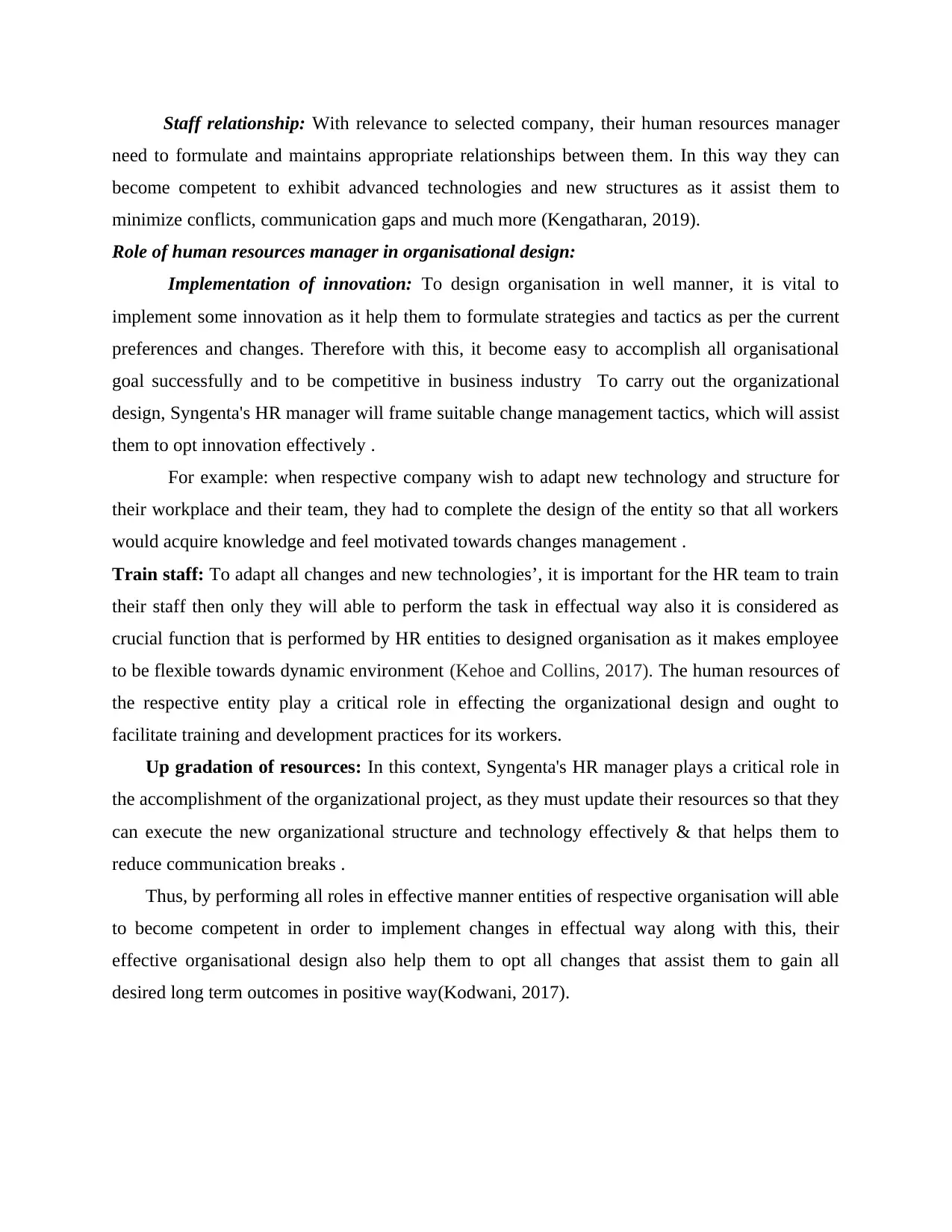
Staff relationship: With relevance to selected company, their human resources manager
need to formulate and maintains appropriate relationships between them. In this way they can
become competent to exhibit advanced technologies and new structures as it assist them to
minimize conflicts, communication gaps and much more (Kengatharan, 2019).
Role of human resources manager in organisational design:
Implementation of innovation: To design organisation in well manner, it is vital to
implement some innovation as it help them to formulate strategies and tactics as per the current
preferences and changes. Therefore with this, it become easy to accomplish all organisational
goal successfully and to be competitive in business industry To carry out the organizational
design, Syngenta's HR manager will frame suitable change management tactics, which will assist
them to opt innovation effectively .
For example: when respective company wish to adapt new technology and structure for
their workplace and their team, they had to complete the design of the entity so that all workers
would acquire knowledge and feel motivated towards changes management .
Train staff: To adapt all changes and new technologies’, it is important for the HR team to train
their staff then only they will able to perform the task in effectual way also it is considered as
crucial function that is performed by HR entities to designed organisation as it makes employee
to be flexible towards dynamic environment (Kehoe and Collins, 2017). The human resources of
the respective entity play a critical role in effecting the organizational design and ought to
facilitate training and development practices for its workers.
Up gradation of resources: In this context, Syngenta's HR manager plays a critical role in
the accomplishment of the organizational project, as they must update their resources so that they
can execute the new organizational structure and technology effectively & that helps them to
reduce communication breaks .
Thus, by performing all roles in effective manner entities of respective organisation will able
to become competent in order to implement changes in effectual way along with this, their
effective organisational design also help them to opt all changes that assist them to gain all
desired long term outcomes in positive way(Kodwani, 2017).
need to formulate and maintains appropriate relationships between them. In this way they can
become competent to exhibit advanced technologies and new structures as it assist them to
minimize conflicts, communication gaps and much more (Kengatharan, 2019).
Role of human resources manager in organisational design:
Implementation of innovation: To design organisation in well manner, it is vital to
implement some innovation as it help them to formulate strategies and tactics as per the current
preferences and changes. Therefore with this, it become easy to accomplish all organisational
goal successfully and to be competitive in business industry To carry out the organizational
design, Syngenta's HR manager will frame suitable change management tactics, which will assist
them to opt innovation effectively .
For example: when respective company wish to adapt new technology and structure for
their workplace and their team, they had to complete the design of the entity so that all workers
would acquire knowledge and feel motivated towards changes management .
Train staff: To adapt all changes and new technologies’, it is important for the HR team to train
their staff then only they will able to perform the task in effectual way also it is considered as
crucial function that is performed by HR entities to designed organisation as it makes employee
to be flexible towards dynamic environment (Kehoe and Collins, 2017). The human resources of
the respective entity play a critical role in effecting the organizational design and ought to
facilitate training and development practices for its workers.
Up gradation of resources: In this context, Syngenta's HR manager plays a critical role in
the accomplishment of the organizational project, as they must update their resources so that they
can execute the new organizational structure and technology effectively & that helps them to
reduce communication breaks .
Thus, by performing all roles in effective manner entities of respective organisation will able
to become competent in order to implement changes in effectual way along with this, their
effective organisational design also help them to opt all changes that assist them to gain all
desired long term outcomes in positive way(Kodwani, 2017).
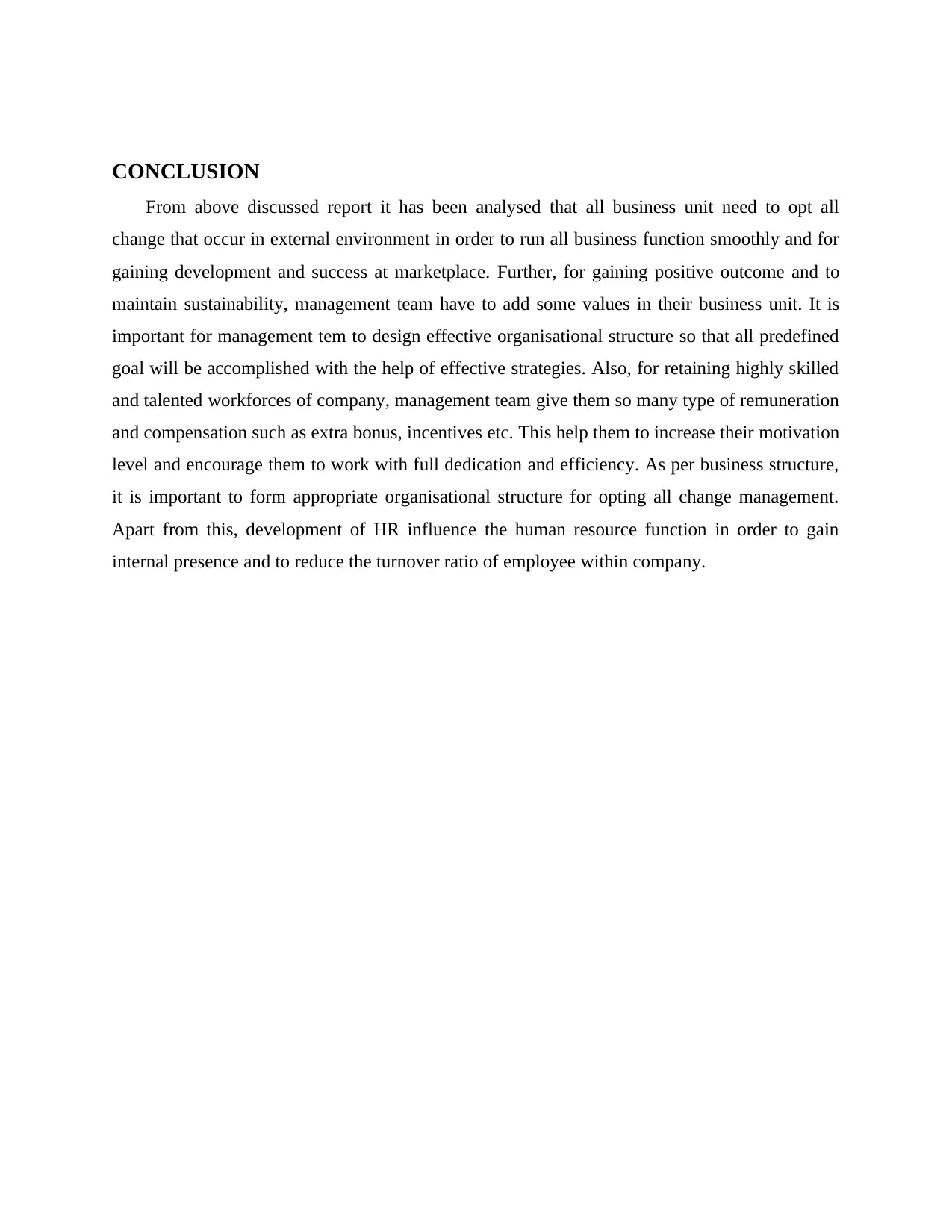
CONCLUSION
From above discussed report it has been analysed that all business unit need to opt all
change that occur in external environment in order to run all business function smoothly and for
gaining development and success at marketplace. Further, for gaining positive outcome and to
maintain sustainability, management team have to add some values in their business unit. It is
important for management tem to design effective organisational structure so that all predefined
goal will be accomplished with the help of effective strategies. Also, for retaining highly skilled
and talented workforces of company, management team give them so many type of remuneration
and compensation such as extra bonus, incentives etc. This help them to increase their motivation
level and encourage them to work with full dedication and efficiency. As per business structure,
it is important to form appropriate organisational structure for opting all change management.
Apart from this, development of HR influence the human resource function in order to gain
internal presence and to reduce the turnover ratio of employee within company.
From above discussed report it has been analysed that all business unit need to opt all
change that occur in external environment in order to run all business function smoothly and for
gaining development and success at marketplace. Further, for gaining positive outcome and to
maintain sustainability, management team have to add some values in their business unit. It is
important for management tem to design effective organisational structure so that all predefined
goal will be accomplished with the help of effective strategies. Also, for retaining highly skilled
and talented workforces of company, management team give them so many type of remuneration
and compensation such as extra bonus, incentives etc. This help them to increase their motivation
level and encourage them to work with full dedication and efficiency. As per business structure,
it is important to form appropriate organisational structure for opting all change management.
Apart from this, development of HR influence the human resource function in order to gain
internal presence and to reduce the turnover ratio of employee within company.
Secure Best Marks with AI Grader
Need help grading? Try our AI Grader for instant feedback on your assignments.
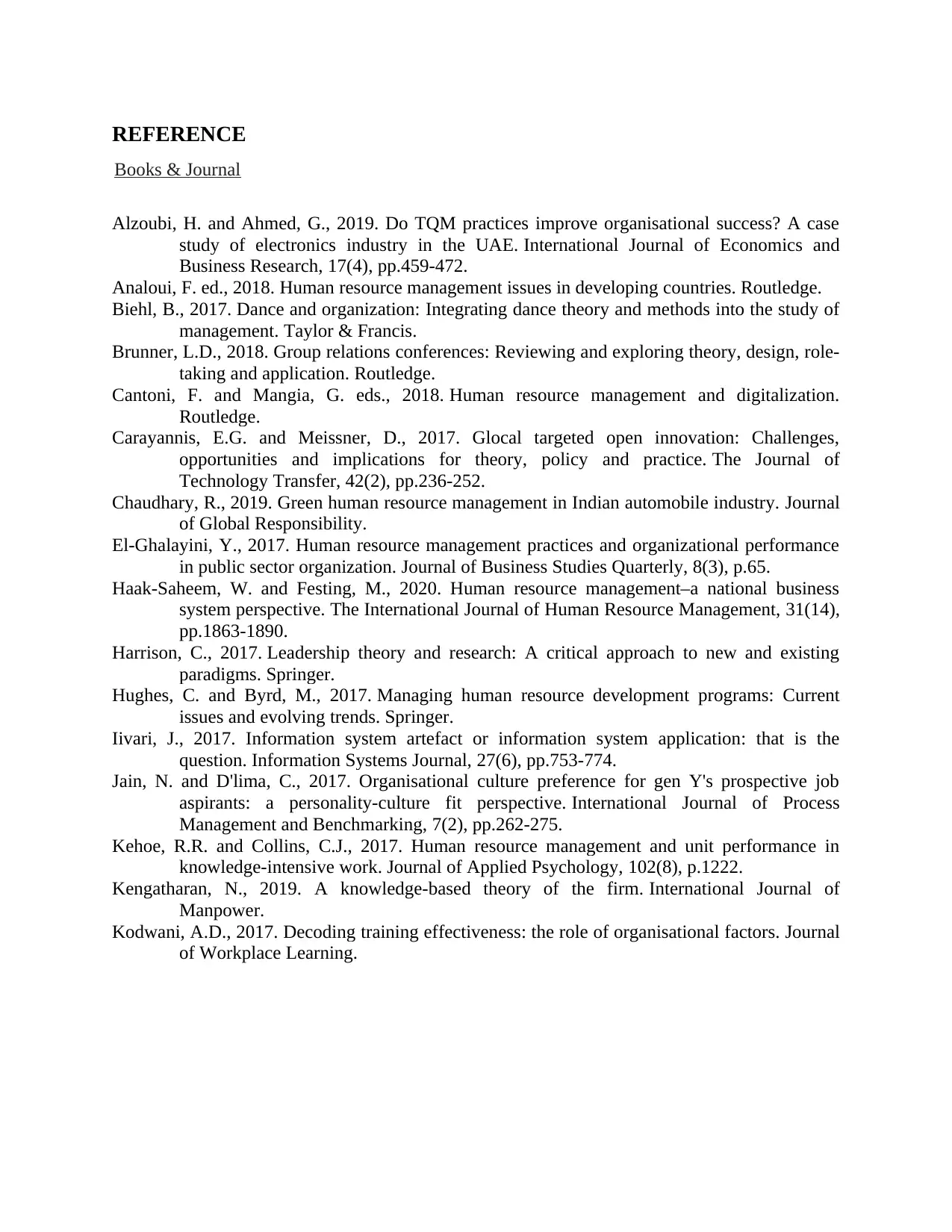
REFERENCE
Books & Journal
Alzoubi, H. and Ahmed, G., 2019. Do TQM practices improve organisational success? A case
study of electronics industry in the UAE. International Journal of Economics and
Business Research, 17(4), pp.459-472.
Analoui, F. ed., 2018. Human resource management issues in developing countries. Routledge.
Biehl, B., 2017. Dance and organization: Integrating dance theory and methods into the study of
management. Taylor & Francis.
Brunner, L.D., 2018. Group relations conferences: Reviewing and exploring theory, design, role-
taking and application. Routledge.
Cantoni, F. and Mangia, G. eds., 2018. Human resource management and digitalization.
Routledge.
Carayannis, E.G. and Meissner, D., 2017. Glocal targeted open innovation: Challenges,
opportunities and implications for theory, policy and practice. The Journal of
Technology Transfer, 42(2), pp.236-252.
Chaudhary, R., 2019. Green human resource management in Indian automobile industry. Journal
of Global Responsibility.
El-Ghalayini, Y., 2017. Human resource management practices and organizational performance
in public sector organization. Journal of Business Studies Quarterly, 8(3), p.65.
Haak-Saheem, W. and Festing, M., 2020. Human resource management–a national business
system perspective. The International Journal of Human Resource Management, 31(14),
pp.1863-1890.
Harrison, C., 2017. Leadership theory and research: A critical approach to new and existing
paradigms. Springer.
Hughes, C. and Byrd, M., 2017. Managing human resource development programs: Current
issues and evolving trends. Springer.
Iivari, J., 2017. Information system artefact or information system application: that is the
question. Information Systems Journal, 27(6), pp.753-774.
Jain, N. and D'lima, C., 2017. Organisational culture preference for gen Y's prospective job
aspirants: a personality-culture fit perspective. International Journal of Process
Management and Benchmarking, 7(2), pp.262-275.
Kehoe, R.R. and Collins, C.J., 2017. Human resource management and unit performance in
knowledge-intensive work. Journal of Applied Psychology, 102(8), p.1222.
Kengatharan, N., 2019. A knowledge-based theory of the firm. International Journal of
Manpower.
Kodwani, A.D., 2017. Decoding training effectiveness: the role of organisational factors. Journal
of Workplace Learning.
Books & Journal
Alzoubi, H. and Ahmed, G., 2019. Do TQM practices improve organisational success? A case
study of electronics industry in the UAE. International Journal of Economics and
Business Research, 17(4), pp.459-472.
Analoui, F. ed., 2018. Human resource management issues in developing countries. Routledge.
Biehl, B., 2017. Dance and organization: Integrating dance theory and methods into the study of
management. Taylor & Francis.
Brunner, L.D., 2018. Group relations conferences: Reviewing and exploring theory, design, role-
taking and application. Routledge.
Cantoni, F. and Mangia, G. eds., 2018. Human resource management and digitalization.
Routledge.
Carayannis, E.G. and Meissner, D., 2017. Glocal targeted open innovation: Challenges,
opportunities and implications for theory, policy and practice. The Journal of
Technology Transfer, 42(2), pp.236-252.
Chaudhary, R., 2019. Green human resource management in Indian automobile industry. Journal
of Global Responsibility.
El-Ghalayini, Y., 2017. Human resource management practices and organizational performance
in public sector organization. Journal of Business Studies Quarterly, 8(3), p.65.
Haak-Saheem, W. and Festing, M., 2020. Human resource management–a national business
system perspective. The International Journal of Human Resource Management, 31(14),
pp.1863-1890.
Harrison, C., 2017. Leadership theory and research: A critical approach to new and existing
paradigms. Springer.
Hughes, C. and Byrd, M., 2017. Managing human resource development programs: Current
issues and evolving trends. Springer.
Iivari, J., 2017. Information system artefact or information system application: that is the
question. Information Systems Journal, 27(6), pp.753-774.
Jain, N. and D'lima, C., 2017. Organisational culture preference for gen Y's prospective job
aspirants: a personality-culture fit perspective. International Journal of Process
Management and Benchmarking, 7(2), pp.262-275.
Kehoe, R.R. and Collins, C.J., 2017. Human resource management and unit performance in
knowledge-intensive work. Journal of Applied Psychology, 102(8), p.1222.
Kengatharan, N., 2019. A knowledge-based theory of the firm. International Journal of
Manpower.
Kodwani, A.D., 2017. Decoding training effectiveness: the role of organisational factors. Journal
of Workplace Learning.
1 out of 11
Related Documents
Your All-in-One AI-Powered Toolkit for Academic Success.
+13062052269
info@desklib.com
Available 24*7 on WhatsApp / Email
![[object Object]](/_next/static/media/star-bottom.7253800d.svg)
Unlock your academic potential
© 2024 | Zucol Services PVT LTD | All rights reserved.





